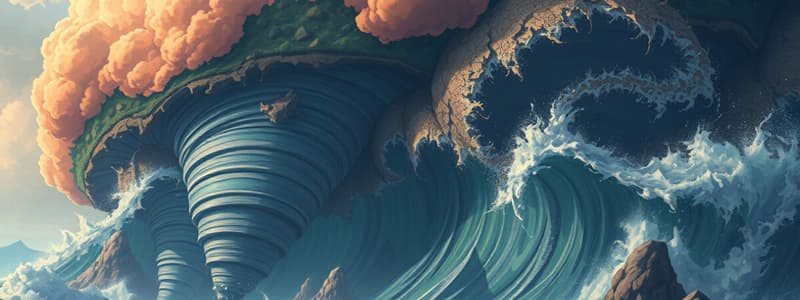Podcast
Questions and Answers
What conditions are necessary for tornado formation in Tornado Alley?
What conditions are necessary for tornado formation in Tornado Alley?
- Warm air alone
- Dry air only
- Warm, moist air meeting cold, dry air (correct)
- Cold air meeting cold air
Hurricanes can only form in cold ocean water.
Hurricanes can only form in cold ocean water.
False (B)
What is the maximum wind speed that a tornado can reach?
What is the maximum wind speed that a tornado can reach?
Over 300 miles per hour
Hurricanes are ranked on the _____ Hurricane Wind Scale.
Hurricanes are ranked on the _____ Hurricane Wind Scale.
Which hurricane is considered one of the most damaging in U.S. history?
Which hurricane is considered one of the most damaging in U.S. history?
The water from a tsunami is typically caused by tectonic activity.
The water from a tsunami is typically caused by tectonic activity.
Name one major hazard caused by tornadoes.
Name one major hazard caused by tornadoes.
Tornadoes form when _____ air meets warm, moist air.
Tornadoes form when _____ air meets warm, moist air.
Match the natural disaster to its characteristic feature:
Match the natural disaster to its characteristic feature:
Which hurricane category is considered the strongest?
Which hurricane category is considered the strongest?
Flashcards are hidden until you start studying
Study Notes
Tornadoes
- Ranked on the Fujita Tornado Damage Scale from F0 (weakest) to F5 (strongest).
- F0 tornadoes have wind speeds under 73 mph; F5 tornadoes exceed 261 mph.
- Commonly form in "Tornado Alley" in the U.S. during spring and summer.
- Form when cold, dry air from Canada meets warm, moist air from the Gulf of Mexico, creating rotating funnel clouds.
- Carry harmful debris, which can damage buildings and property.
Tsunamis
- Caused by underwater earthquakes or volcanic eruptions, resulting in series of long waves.
- Initially low in height due to deep ocean water, but can increase significantly as they approach shallow coastal areas.
- Some tsunamis have produced waves over 100 feet high.
- Notable tsunami in 2004 killed over 200,000 in Indonesia, highlighting significant impact on coastal regions.
Floods
- Occur from prolonged heavy rainfall leading water bodies to overflow.
- Can cause destruction to infrastructure like roads, bridges, and homes.
- Floods are categorized as slow or flash floods, with flash floods being extremely dangerous due to rapid onset.
Volcanic Eruptions
- Involve discharge of gases, ash, and molten rock from Earth's crust.
- Eruptions can vary from explosive to gentle.
- Create new landforms as lava cools and solidifies, contributing to Earth's crust.
- Major types of volcanoes include shield, composite, and cinder cone.
- Significant volcanic activity concentrated in the Pacific Ring of Fire, includes Mount Fuji, Mount St. Helens, and Mount Pinatubo.
Earthquakes
- Sudden shaking caused by shifts at tectonic plate boundaries, predominantly in the Pacific Ring of Fire.
- Major risks include building collapses and gas line ruptures, which can ignite fires.
- Measured using seismographs, with magnitude determined by the Richter Scale.
- The largest recorded earthquake occurred in Chile in 1960, rated 9.5 on the Richter Scale.
Wildfires
- Uncontrolled fires that can devastate forests, grasslands, and residential areas.
- Rapid spread due to environmental factors and human activity, including arson.
- Result in loss of wildlife and crops.
- High winds can prolong the fire’s duration and distance traveled.
Droughts
- Result from prolonged lack of rainfall, severely affecting agriculture and ecosystems.
- Cannot be accurately predicted, necessitating water conservation measures.
Landslides
- Involve the downward movement of soil and debris, often triggered by heavy rain or earthquakes.
- Can reshape landscapes and pose risks to populated areas.
Hurricanes
- Rotating tropical storms with winds exceeding 150 mph, rated on the Saffir-Simpson Hurricane Wind Scale from Category 1 to 5.
- Form over warm ocean waters (80°F or warmer) and cause extensive wind damage and flooding upon making landfall.
- Category 1 hurricanes have winds between 74-95 mph; Category 5 hurricanes exceed 157 mph.
- Hurricane Harvey (2017) and Hurricane Katrina (2005) are notably destructive and costly storms in U.S. history.
Natural Disasters
- Catastrophic events caused by natural processes that lead to injury, death, and destruction.
- Can significantly alter Earth's surface and contribute to processes like weathering and erosion.
Studying That Suits You
Use AI to generate personalized quizzes and flashcards to suit your learning preferences.



